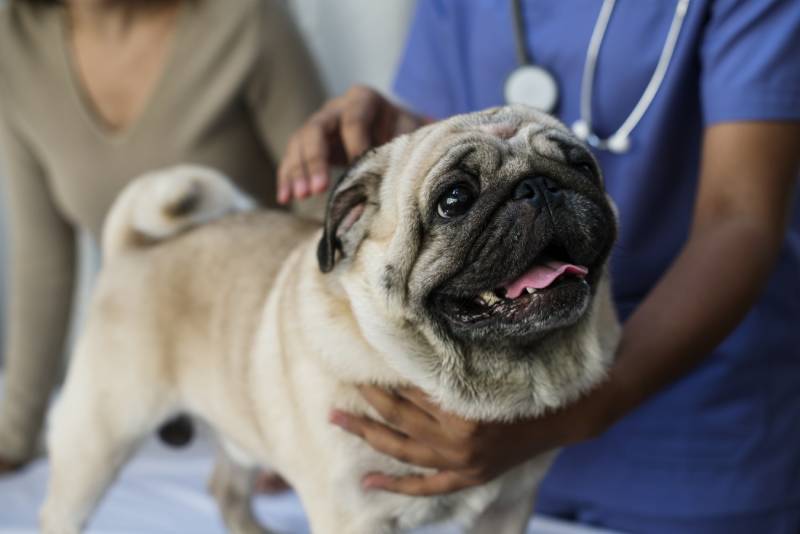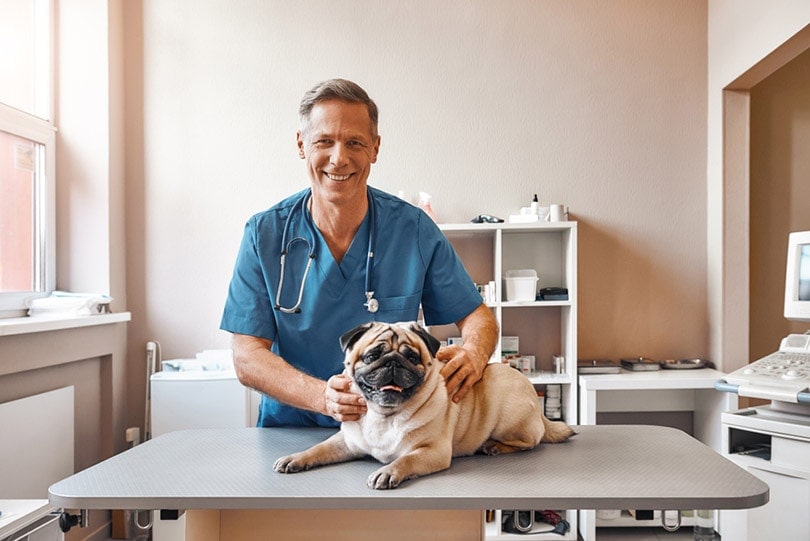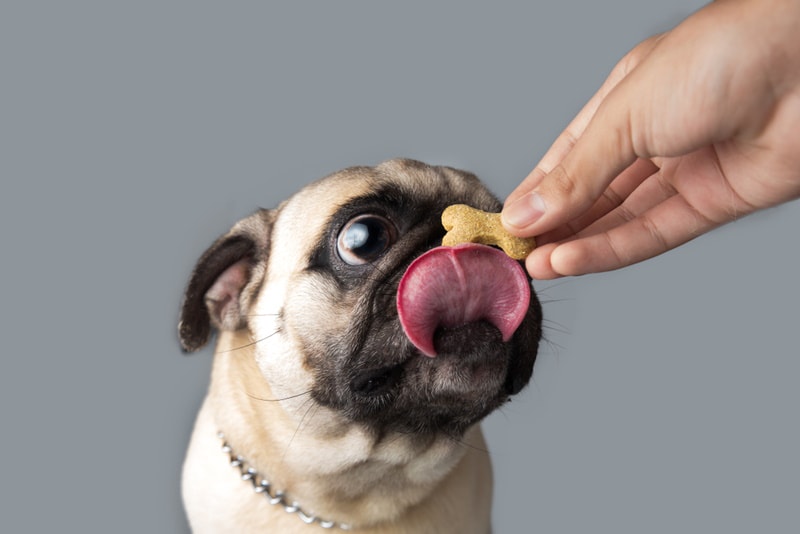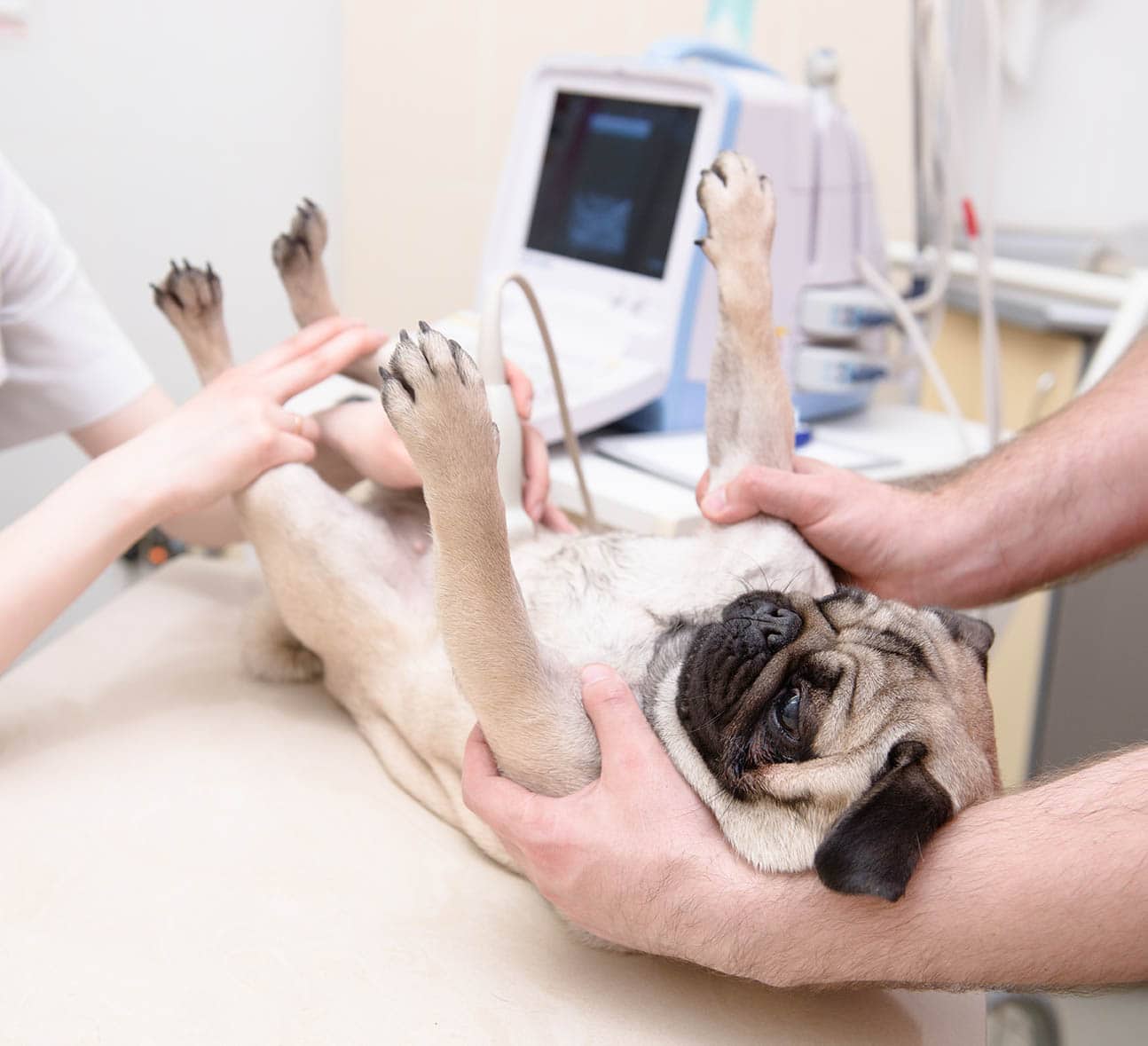Pug Pregnancy: What to Expect & Expert Tips (Vet Answer)
Updated on

Click to Skip Ahead
There are few things cuter than a pug puppy. I consider this a universally accepted fact. This popular breed is known for its small stature, big personality, expert-level eye contact, and loyal roots. It is no surprise they are such an in-demand breed, but they come with several physical characteristics, making breeding pugs more difficult than most other dog breeds.
It helps to know as much as you can, so we have compiled a list of 16 things about pug pregnancies for you!
The 3 Tips for Preparing for the Pregnancy
1. Medications
Not all medications are safe for pregnant dogs. If your pug takes any medications or supplements, topically, orally, or otherwise, you will want to consult with a veterinarian before breeding your female pug if possible. If she has taken this pregnancy into her own paws, it’s best to check in with a veterinarian as soon as you suspect she has a chance of being pregnant.

2. Parasite Control
While speaking to a veterinarian to clear your pug for pregnancy, be sure to get her up to date on heartworm, flea, and tick prevention that is safe for pregnant dogs. These preventatives also prevent intestinal worms, which are important since some parasites and diseases can pass from a pregnant mother to her fetuses or newborns. Pregnant pugs that become ill or pick up a parasite may be at risk for developmental disorders in their puppies, some of which can be fatal.
3. Vaccination
Ideally, pregnant and lactating pugs should not receive any vaccinations. A quick check-in with your veterinary clinic will tell you if any vaccines are overdue or coming due during the period you expect your pug to be busy creating and feeding new life. When possible, vaccinations immediately prior to breeding can allow the mother to pass some of her immunity onto her puppies better, so be sure to check in with your veterinarian if you would be interested in checking if this is a possibility for your pug.

The 7 Tips for Breeding and Pregnancy
4. Artificial Insemination
You will be happy to learn that artificial insemination is not required for pug breeding. It can be the safest option in some cases, eliminating the risk of certain sexually transmitted infections and physical trauma. Though not the cheapest option, avoiding health costs associated with complications from breeding can turn out cheaper in the long run.
5. Diet
Pregnant pugs will have higher caloric needs while pregnant and lactating. Commercial dog diets of all sorts will come with something called an AAFCO statement on the bag, which certifies them as meeting the nutritional requirements for various life stages. For pregnant dogs, you want to keep them on a diet labeled for gestation, lactation, growth, and all life stages. Be sure to use this diet throughout the whole pregnancy and nursing period.

6. Supplements
If your pug is being fed a nutritionally adequate diet as advised above, no supplements are needed for your pug during pregnancy. Sometimes owners will wish to give their pug calcium supplements, but this is not advisable. Her body creates hormones so she can produce calcium as needed.
If providing supplemental calcium, her body will stop producing these hormones, and during certain periods of the pregnancy and especially nursing, when she needs more, she may not get or produce enough because of this, which can cause an emergency called eclampsia.
7. Exercise
Daily low-level exercise like walking is good for pregnant pugs. Be careful of temperatures as pugs are very sensitive to temperatures above 80°F, which is even more true while pregnant. High-intensity exercise is not recommended, nor are activities with other dogs, especially if you do not know those dogs.
On the flip side, obesity can be especially dangerous for pregnant dogs and is a critical concern for pugs, so be sure to balance keeping your pug lean and active without using stressful or high-intensity exercise.

8. Isolation
Some infections that a pregnant pug could get can cause abortion or death of newborn puppies if they become sick at the wrong part of their pregnancy. Due to this, the safest thing you could do for your pregnant pug is to keep her away from all other dogs for three weeks before delivery and three weeks after.
9. Gestational Period
Dogs, including pugs, are pregnant for 63 days on average. It is best to be prepared for a window of five days before or after as your likely whelping window, though you would be surprised how exactly on time they can be.
10. Check-Ups
In addition to seeing a veterinarian before breeding, when possible, there are some check-up dates you’ll want to keep track of also. Your first check should be at 30 days of pregnancy. The veterinarian can use an ultrasound or a blood test to confirm pregnancy. Another visit at 45 days will allow for an X-ray to count puppies. This is very important for delivery, as you will need to know when she has finished.

The 6 Tips for Labor
11. Whelping Box
You want to prepare an area by about day 58 for your pregnant pup to whelp. Though often called a whelping box, this can be a room, a kennel, a sectioned-off area, etc. This area should be comfortable and stress-free; she can also come and go later while keeping the puppies in place. She may or may not choose to have the puppies here, but you want the area comfortable and familiar for her to transition to afterward as needed.
12. Signs of Labor
Around this same timeframe, you will want to start taking regular rectal temperatures from your pregnant pug. Her temperature, which will typically be about 101°F or higher, will drop below 100°F when labor is likely coming in the next 24 hours.

13. C-Sections
A cesarean section (or C-section) is a surgical procedure in which a veterinarian accesses a dog’s uterus to collect all the puppies. It is used most often for dogs suspected of not being able to birth their puppies on their own without concerns for the mother or puppies or dogs that are in labor and encounter a problem, such as a stuck puppy.
Pugs are not a breed that requires a C-section, but for some smaller females, it isn’t an uncommon procedure to need. Your veterinarian will let you know during your pug’s pregnancy check-up appointments if they would like to schedule a C-section for your pug and, if so, when.
14. Labor
The length of time to expect your pug’s labor to last depends on how many puppies she has. As a general guideline, the initial stages of labor, before the first puppy comes, consist of specific behaviors like agitation, pacing, restlessness, digging, shivering, or panting, and can last for up to 6–12 hours.
Once puppies start to come, you should expect a puppy every 45–60 minutes. In larger litters, your pug may need to take a break between puppies, which can take up to 4 hours, which is okay if she isn’t straining hard during this time.
15. Normal Occurrences
Some changes that would be concerning in a normal dog are to be expected during labor for your pug. An example of this would be spiking a fever, which can be normal for 1-2 days after giving birth if she does not show other signs of illness.
Vaginal discharge of various colors, including green, red, brown, or clear, if it is odorless, is also normal.

16. Abnormal Occurrences
You will also want to know when you have an issue you should call a veterinarian for. If your pug has strong contractions for longer than an hour without producing a puppy or goes more than 4 hours without a puppy, even if calm, you should contact your veterinarian.
If your pug does not go into labor within 24 hours of her temperature drop, becomes extremely painful, or you make it to day 70 with no signs of labor, these are also signs you should contact your veterinarian.
Conclusion
Pugs are fantastic little dogs, but due to their short faces and tight airways, it is important to optimize every aspect of their care that you can before pregnancies and be as informed on what is normal and abnormal as you can be. We hope this list has given you everything you need to proceed with confidence and don’t forget to check in with your pug’s veterinarian for more personalized help.
Featured Image Credit: Ezzolo, Shutterstock












